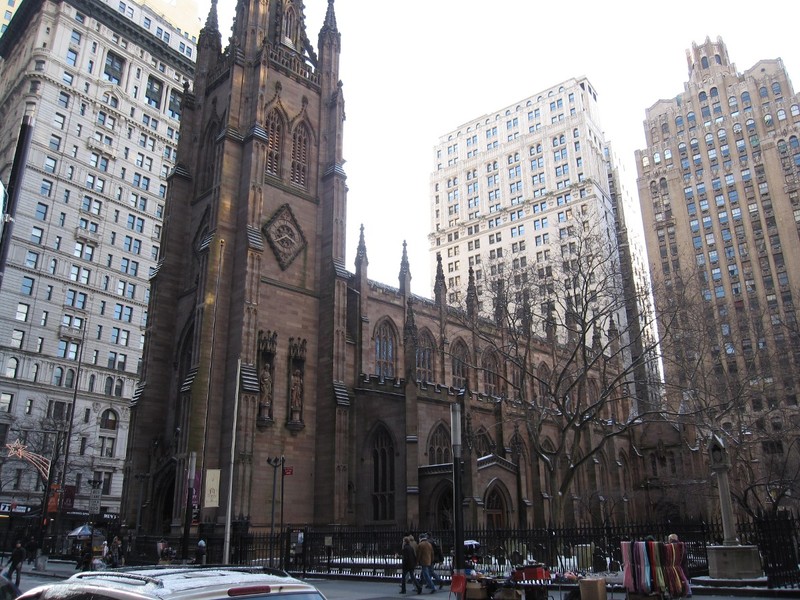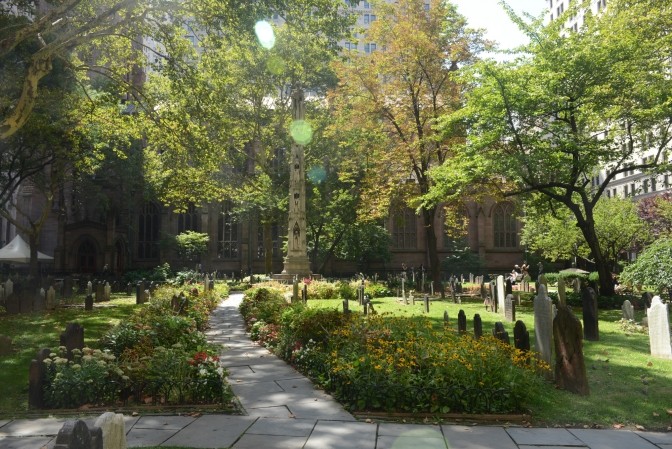This entry includes a walking tour! Take the tour.
Introduction
Text-to-speech Audio
Images
The current Trinity Church

Trinity's churchyard serves as the final resting place for many historic figures from the colonial period to the 19th century.

Backstory and Context
Text-to-speech Audio
In 1696, the Anglican community purchased land in Lower Manhattan to construct a new church with the approval of Governor Benjamin Fletcher. The first Trinity Church was constructed in 1698. The first minister was William Vesey who served for 49 years. In 1705, the parish's land holdings were increased to 215 acres by Queen Anne of England. During the American Revolutionary War, New York City became a British military and political base. As a result, the clergy of the church were required to be Loyalists. The church was burned down in the Great New York City Fire of 1776, which destroyed almost one-third of the city because most of the firemen in the city had gone to serve with General Washington. Many people thought the fire had been deliberately set because at that time New York City was facing the possibility of being captured by the British, and by burning down the city, the British would gain nothing. After the war, in 1784, the New York state legislature ratified the charter of Trinity Church but deleted any reference to being loyal to the King of England. The second Trinity Church was constructed in 1790, but it survived for less than 50 years. It was torn down after the winter of 1838 because of damage cause by severe snows that winter.
The current Trinity Church, which is the third Trinity Church, was constructed in 1846. The building’s Gothic Revival architecture was designed by architect Richard Upjohn. It was the tallest building in New York City until 1890. Trinity Church also withstood the 9/11 attack. After the collapse of the towers, the church served as a refuge. Trinity Church was designated as a National Historic Landmark on December 8, 1976.
Trinity Church is associated with three burial grounds: Trinity Churchyard, Trinity Church Cemetery and Mausoleum, and the Churchyard of St. Paul's Chapel. The first one to open was the Trinity Churchyard in 1697. Since then, those burial grounds have been the final resting spots for many historic figures, such as Alexander Hamilton, Robert Fulton, John Adams Dix, and Alfred D'Orsay Tennyson Dickens.
The following video was produced by the Library of Congress using footage taken from film produced in 1903. The film shows a view of traffic looking north on Broadway at the intersection of Wall Street, just in front of the Trinity Church. As a way to get a feel for the changes that have occurred over time, stand at this intersection and look north, holding your mobile device against the modern landscape while playing the video below.
Sources
(1) "Sacred Destinations." Trinity Church - New York City, New York. Accessed April 01, 2017. http://www.sacred-destinations.com/usa/new-york-city-trinity-church.
(2) "New York Architecture Images- TRINITY CHURCH." New York Architecture Images- TRINITY CHURCH. Accessed April 01, 2017. http://www.nyc-architecture.com/LM/LM047-TRINITYCHURCH.htm.
(3) "The Great Fire of 1835/Introduction." The Great Fire of 1835/Introduction. Accessed April 01, 2017. http://www.virtualny.cuny.edu/FIRE/greatfire1776.html.
